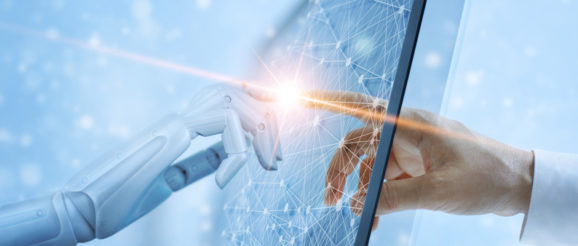Innovation, Artificial Intelligence, and the Bedside Nurse – Daily Nurse

Nurses have always played a critical role at the bedside while bearing witness to numerous changes in technology. In the past 50 years alone, the advancements seem unfathomable to nurses of the not-so-distant past such as “test-tube” babies, medical lasers, the artificial heart, genome mapping, CT and MRI imaging, angioplasty, dialysis, endoscopic procedures, bionic prosthetics, the internet and health information technology (IT), the electronic health record (EHR), and robotic surgeries. However, as health care races toward telemedicine and artificial intelligence, nurses must strategically position themselves to stay relevant.
In a recent article in Nursing Management, the author stated: “Artificial Intelligence (AI) is a branch of computer science dealing with the simulation of intelligent behavior in computers. Combining the experience, knowledge, and human touch of clinicians with the power of AI will improve the quality of patient care and lower its cost.” While most nurses have been immersed in the EHR for a decade (or more, depending on the organization), the industry still struggles with quality vs. quantity of input data that will allow for valid information mining, utilizing AI to identify areas of risk, or even the pending decline of a patient.
However, the question of quality data is often reviewed by those who are responsible for an organization’s health care IT. Many nurses who jumped into the AI and innovative world of informatics struggle with orchestrating what constitutes valuable data the bedside nurse is required to input versus each discipline’s desire to have the information captured. For example, while it is important to the dietician to know which brand of tube feeding was administered to the patient, does it truly add value enough to warrant one more line on the 1,000+ EHR rows for the nurse to capture? Preserving documentation requirements to the essential data points will not only help bedside nurses save precious time, but also allow for predictability models to work in the background to anticipate patients who may decline.
Bedside nurses are the key to AI as it relates to predictability models and telemedicine. Data points such as temperature, blood pressure, and physical assessment values, entered into the EHR in a timely manner, can literally make the difference between life and death as the health information technology is scanning thousands of factors to provide outcome information. Getting nurses onboard with real-time, accurate documentation (not just copying the assessment from the previous shift) is essential. “Nurses are viewing AI as telling them what to do instead of using the insights AI provides as part of their clinical decision,” states Dan Weberg, PhD, RN. “In order for nurses to stay relevant, we need to figure a way to incorporate new technology directly into practice. AI isn’t making decisions for us as nurses, it’s making us super nurses!”
Dr. Weberg, who has worked as an innovation specialist for multiple health systems and academic institutions across the U.S., states that nurses need to demand a seat at the innovation table. Each year, more and more institutions are developing smart health apps that directly affect nursing. Yet the absence of the nurse in the concept and design is palpable. Many times, nurses are not brought into a project until it is time to implement the technology, which is a challenging time to make any nurse-recommended changes. When technology is designed and implemented without nursing input, workarounds are created, which can lead to the innovation not being used to its full capacity.
The lack of enthusiasm and embracement of technology may
start in nursing schools, according to Dr. Weberg. “There is a gap between the
traditional, old-school methods of teaching students how to be nurses and
actual innovation in practice. Academia needs to foster a healthy relationship
between nursing and advancing technology if we want to remain relevant.” One
would assume that as nurses are sworn to advocate for and protect patients,
embracing technology that improves patient outcomes should be obvious.
When artificial intelligence and modern technology are infused with the art of medicine, patients are safer. In a study conducted by the Institute of Medicine in 2000, it was found that 10% of medical diagnoses were wrong. The report, called To Err is Human, called for technological advances such as physician order entry to reduce the guessing game in deciphering clinician handwriting. Since that report nearly 20 years ago, many studies have proven that there are less medication errors, less adverse drug reactions, and improved compliance to evidence-based practice guidelines with the integration of health information technology.
As health care technology continues to evolve at a rapid pace, it is not just the encompassing profession of nursing that needs to be in on the change. Bedside nurses can strive to become “super users” in their departments as subject-matter experts in any technology or innovation that is being designed and implemented. Staying one step ahead and developing a mindset of improvement and innovation can be powerful. For the nurses who complain that “things are always changing too much” who long for the trifold, 2-sided, chart-in-the-color-of-your-shift days, that ship has sailed – and good riddance. The future of nursing is aglow with the megahertz light of innovation to improve the lives of nurses, patients, and the communities we serve.
Latest posts by Catherine Burger, BSN, MSOL, RN (see all)
Get more news like this – plus jobs – each week.
Subscribe to The Weekly Boost – the weekly email newsletter for DailyNurse.
